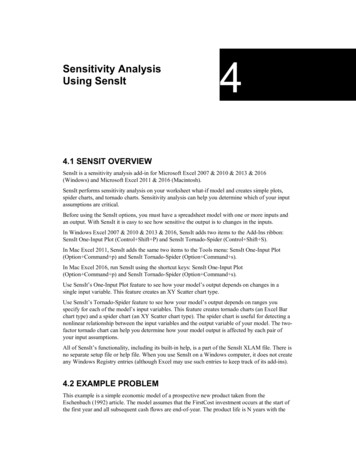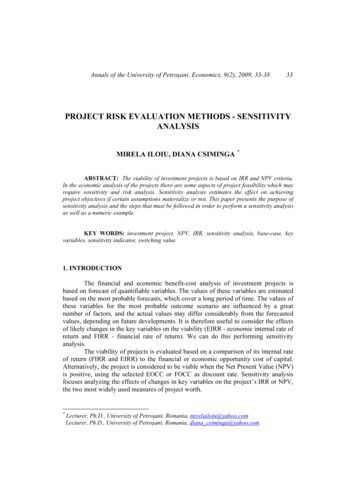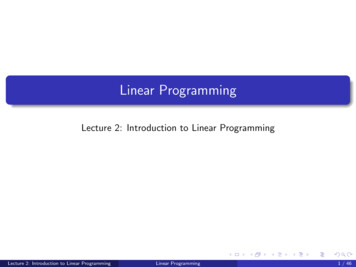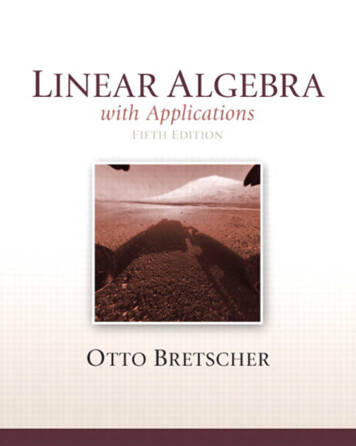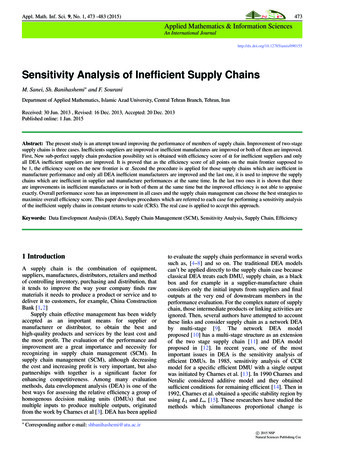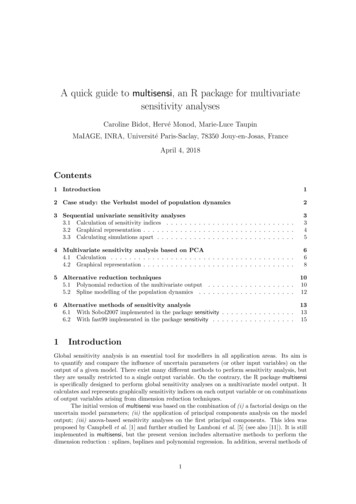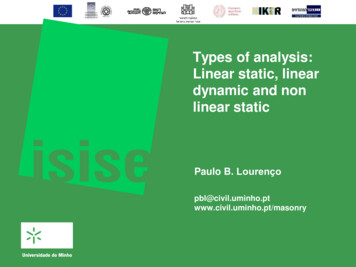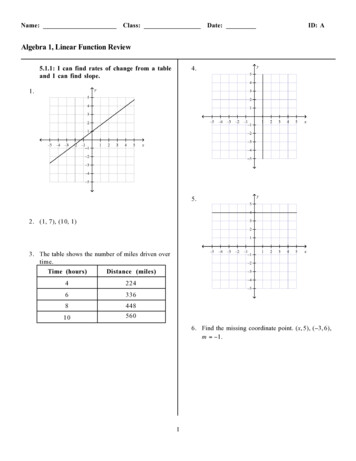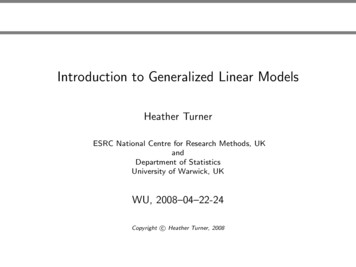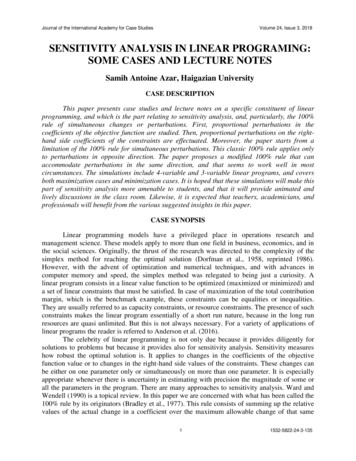
Transcription
Journal of the International Academy for Case StudiesVolume 24, Issue 3, 2018SENSITIVITY ANALYSIS IN LINEAR PROGRAMING:SOME CASES AND LECTURE NOTESSamih Antoine Azar, Haigazian UniversityCASE DESCRIPTIONThis paper presents case studies and lecture notes on a specific constituent of linearprogramming, and which is the part relating to sensitivity analysis, and, particularly, the 100%rule of simultaneous changes or perturbations. First, proportional perturbations in thecoefficients of the objective function are studied. Then, proportional perturbations on the righthand side coefficients of the constraints are effectuated. Moreover, the paper starts from alimitation of the 100% rule for simultaneous perturbations. This classic 100% rule applies onlyto perturbations in opposite direction. The paper proposes a modified 100% rule that canaccommodate perturbations in the same direction, and that seems to work well in mostcircumstances. The simulations include 4-variable and 3-variable linear programs, and coversboth maximization cases and minimization cases. It is hoped that these simulations will make thispart of sensitivity analysis more amenable to students, and that it will provide animated andlively discussions in the class room. Likewise, it is expected that teachers, academicians, andprofessionals will benefit from the various suggested insights in this paper.CASE SYNOPSISLinear programming models have a privileged place in operations research andmanagement science. These models apply to more than one field in business, economics, and inthe social sciences. Originally, the thrust of the research was directed to the complexity of thesimplex method for reaching the optimal solution (Dorfman et al., 1958, reprinted 1986).However, with the advent of optimization and numerical techniques, and with advances incomputer memory and speed, the simplex method was relegated to being just a curiosity. Alinear program consists in a linear value function to be optimized (maximized or minimized) anda set of linear constraints that must be satisfied. In case of maximization of the total contributionmargin, which is the benchmark example, these constraints can be equalities or inequalities.They are usually referred to as capacity constraints, or resource constraints. The presence of suchconstraints makes the linear program essentially of a short run nature, because in the long runresources are quasi unlimited. But this is not always necessary. For a variety of applications oflinear programs the reader is referred to Anderson et al. (2016).The celebrity of linear programming is not only due because it provides diligently forsolutions to problems but because it provides also for sensitivity analysis. Sensitivity measureshow robust the optimal solution is. It applies to changes in the coefficients of the objectivefunction value or to changes in the right-hand side values of the constraints. These changes canbe either on one parameter only or simultaneously on more than one parameter. It is especiallyappropriate whenever there is uncertainty in estimating with precision the magnitude of some orall the parameters in the program. There are many approaches to sensitivity analysis. Ward andWendell (1990) is a topical review. In this paper we are concerned with what has been called the100% rule by its originators (Bradley et al., 1977). This rule consists of summing up the relativevalues of the actual change in a coefficient over the maximum allowable change of that same11532-5822-24-3-135
Journal of the International Academy for Case StudiesVolume 24, Issue 3, 2018coefficient (upper or lower limit). See Filippi (2011) and Anderson et al. (2016). Filippi (2011) isa recent derivation of the 100% rule, and he states that “if we are interested in perturbations thatincrease the right-hand side coefficients, we need to check only one (additive) inequality”. As aninstance if the current value of a coefficient is 20 and the maximum allowable decrease, or lowerlimit, is 10, then a change to 15 corresponds to the following ratio:(15-20)/(10-20) 0.50If another coefficient has a current value of 12 and a maximum allowable change orupper limit of 25, then a change to 16 corresponds to the following ratio:(16-12)/(25-12) 0.31Summing up these two ratios produces:0.50 0.31 0.81 1 100%And the 100% rule is satisfied. The rule is not satisfied if the sum falls above 1 or 100%.What conclusions can we draw in this case? If the two changes are for coefficients of theobjective value function, then:1.The optimal solution does not change.2.The total value of the objective function changes.3.Knowing the changes in the coefficients, the new level of the objective function can be calculated.If the two changes are for the right-hand side parameters of the constraints of theproblem, then:1.The dual or shadow prices do not change.2.The solution changes.3.The binding constraints remain binding.4.The non-binding constraints remain non-binding.5.The total value of the objective function changes.6.Knowing the intended changes, and knowing the dual prices, one can calculate the change in the valueof the objective function, and from there the total of the new function value. For each constraint thechange in the constraint parameter is multiplied by the dual price of that constraint and thenappropriately summed up across the two constraints.These outcomes are said to be a part of a sensitivity analysis in the linear program.Briefly checking whether the 100% rule is satisfied and adopting the implied results is thepurpose of sensitivity analysis.If the program is composed of only two decision variables, then there is a second methodfor obtaining the new value of the objective function. This is by solving first for the new optimalsolution from the binding constraints, and replacing this solution in the objective function.In case the 100% rule is not satisfied we conclude that we need to resolve the problem.The optimal solution may not change if the changes are in the coefficients of the objective21532-5822-24-3-135
Journal of the International Academy for Case StudiesVolume 24, Issue 3, 2018function. And the shadow prices may not change if the changes are in the right-hand sideparameters. Therefore, in this case, there is ambiguity and we are not sure about what willhappen. Satisfying the 100% rule has strong implication on either the solution, or the dual prices.But if the 100% rule is not satisfied then one cannot say that either the solution changes or thatthe dual prices change, but simply: we need to resolve. The solution and the dual prices may notchange despite the rejection of 100% rule.There is a caveat. The 100% rule described above applies only for changes in oppositedirection although this is not clear from the textbook that reports it (Anderson et al., 2016). Forchanges in the same direction the 100% rule must be modified. This paper will propose amodification of the 100% rule later which works well in most circumstances. Simply put, thenew rule is by taking the absolute value of the subtraction of the percent relative changes. Thefundamental change in the rule is subtraction instead of addition, while taking absolute values.This paper is organized as follows. In the following section, section 2, the two caseproblems that will be studied are presented, together with the reason for their selection. In thissection, the different scenarios are also depicted. Section 3 dwells upon the cases where theobjective functions are multiplied threefold. Section 4 dwells upon the cases when thecoefficients of the right-hand side constraints are multiplied threefold. Section 5 dwells uponsimultaneous perturbations in the right-hand side coefficients of the constraints. Section 6 dwellsupon simultaneous perturbations in the coefficients of the objective functions. The final sectionsummarizes and concludes. In sections 5 and 6 is introduced the modified 100% rule forsimultaneous perturbations in the same direction. This rule seems to work well in mostcircumstances, and, hence, should be included in more recent editions of textbooks on operationsresearch.LINEAR PROGRAM SETUPAt first, two linear programs will be studied, one maximization and one minimization.The maximization will consist of three or four decision variables. This choice is made for thepurpose of illustrating higher-order problems. Likewise, the minimization will consist of three orfour decision variables. The purpose is to be as general as possible. Each linear program will besubjected to two perturbations, one by multiplying the objective function by three, keeping thesame constraints, and the other by multiplying the right-hand side values by three, keeping thesame objective function. The scalar 3 is arbitrary. The impact of these perturbations on the initialsolution will be analyzed and reported.For the maximization with 4 decision variables, two different perturbations will beapplied. Both are carried out by choosing arbitrarily the perturbations. These perturbations willbe effectuated on the right-hand side coefficients of the constraints. The modified 100% rule willbe restated and solved. The purpose is the selection of perturbations that lead to failure of theordinary 100% rule. For the minimization with four decision variables the two independent andarbitrary perturbations are imposed on the right-hand side coefficients of the constraints and theyare selected in such a way as to have them fail the ordinary 100% rule. The results of all theseperturbations will be analyzed and classified.31532-5822-24-3-135
Journal of the International Academy for Case StudiesVolume 24, Issue 3, 2018The maximization with four decision variables is as follows:Maximize: X1 X2 2X3 2X4Subject to:X1 2X2 3X3 3X4 15,0002X1 4X2 X3 3X4 20,0003X1 2X2 5X3 3X4 20,000X1 1,000X2 1,000X3 1,000X4 1,000The non-negativity constraints will apply always but are not listed and repeated. Thesolution and sensitivity analysis to this linear program are presented in Table 1. The computeroutput has been processed using the Management Scientist software, a copy of which isappended to the textbooks of Anderson et al. (2016).Table 1MAXIMIZATION OF THE 4-VARIABLE LINEAR PROGRAM: BASIC SOLUTIONOPTIMAL SOLUTIONObjective Function Value 10166.667VariableValueReduced X42833.3330.000ConstraintSlack/SurplusDual VE COEFFICIENT RANGESVariableLower LimitCurrent ValueUpper LimitX10.6671.0002.000X2No Lower Limit1.0001.333X3No Lower Limit2.0002.333X41.5002.0003.000RIGHT HAND SIDE RANGESConstraintLower LimitCurrent ValueUpper 00No Upper Limit319000.00020000.00027000.0004No Lower 000.0001500.00041532-5822-24-3-135
Journal of the International Academy for Case StudiesVolume 24, Issue 3, 2018Table 1MAXIMIZATION OF THE 4-VARIABLE LINEAR PROGRAM: BASIC SOLUTIONNo Lower Limit1000.0002833.3337The minimization with four decision variables is as follows:Minimize: 0.4X1 0.2X2 0.2X3 0.3X4Subject to:X1 X2 X3 X4 363X1 4X2 8X3 6X4 2805X1 3X2 6X3 6X4 20010X1 25X2 20X3 40X4 280The solution and the sensitivity analysis of this linear program are presented in Table 2.Table 2MINIMIZATION OF THE 4-VARIABLE LINEAR PROGRAM: BASIC SOLUTIONOPTIMAL SOLUTIONObjective Function Value 7.200VariableValueReduced .100ConstraintSlack/SurplusDual .000OBJECTIVE COEFFICIENT RANGESVariableLower LimitCurrent ValueUpper LimitX10.2000.400No Upper 00No Upper LimitRIGHT HAND SIDE RANGESConstraintLower LimitCurrent ValueUpper Limit135.00036.00070.0002266.667280.000288.0003No Lower Limit200.000210.0004No Lower Limit280.000730.000Multiplying Threefold the Objective FunctionsThe computer outputs relevant to multiplying threefold the objective function arepresented respectively in Tables 3 and 4.For the maximization (Table 3), the results of this multiplication are as follows:1.The objective function value is multiplied threefold.51532-5822-24-3-135
Journal of the International Academy for Case StudiesVolume 24, Issue 3, 20182.The optimal solution is the same.3.The ranges of optimality, i.e. the ranges for the coefficients of the objective function, are multipliedthreefold.4.The dual prices are multiplied threefold.5.The slack and surpluses remain the same.6.The binding constraints remain binding.7.The non-binding constraints remain non-binding.8.The ranges of feasibility, i.e. the ranges for the right-hand side coefficients, are all the same.Table 3MAXIMIZATION OF THE 4-VARIABLE LINEAR PROGRAM: THE OBJECTIVEFUNCTION MULTIPLIED THREEFOLDOPTIMAL SOLUTIONObjective Function Value 30500.000VariableValueReduced X42833.3330.000ConstraintSlack/SurplusDual IVE COEFFICIENT RANGESVariableLower LimitCurrent ValueUpper LimitX12.0003.0006.000X2No Lower Limit3.0004.000X3No Lower Limit6.0007.000X44.5006.0009.000RIGHT HAND SIDE RANGESConstraintLower LimitCurrent ValueUpper 00No Upper Limit319000.00020000.00027000.0004No Lower 000.0001500.0007No Lower Limit1000.0002833.333For the minimization (Table 4), the results of this multiplication are as follows:1.The objective function value is multiplied threefold.2.The optimal solution is the same.3.The reduced costs are multiplied threefold.61532-5822-24-3-135
Journal of the International Academy for Case StudiesVolume 24, Issue 3, 20184.The ranges of optimality, i.e. the ranges for the coefficients of the objective function, are multipliedthreefold.5.The dual prices are multiplied threefold.6.The slack and surpluses remain the same.7.The binding constraints remain binding.8.The non-binding constraints remain non-binding.9.The ranges of feasibility, i.e. the ranges for the right-hand side coefficients, are all the same.Table 4MINIMIZATION OF THE 4-VARIABLE LINEAR PROGRAM: OBJECTIVE FUNCTIONMULTIPLIED THREEFOLDOPTIMAL SOLUTIONObjective Function Value 21.600VariableValueReduced .300ConstraintSlack/SurplusDual .000OBJECTIVE COEFFICIENT RANGESVariableLower LimitCurrent ValueUpper LimitX10.6001.200No Upper 0No Upper LimitRIGHT HAND SIDE RANGESConstraintLower LimitCurrent ValueUpper Limit135.00036.00070.0002266.667280.000288.0003No Lower Limit200.000210.0004No Lower Limit280.000730.000Multiplying Threefold the Right-Hand Side CoefficientsThe computer outputs relevant to multiplying threefold the right-hand side coefficients ofthe four-variable maximization program are presented in Table 5. For this maximization theresults of this multiplication are as follows:1.The objective function value is multiplied threefold.2.The optimal solution is multiplied threefold.3.The ranges of optimality are the same.4.The dual prices remain the same.5.The slacks are multiplied threefold.71532-5822-24-3-135
Journal of the International Academy for Case StudiesVolume 24, Issue 3, 20186.The binding constraints remain binding.7.The non-binding constraints remain non-binding.8.The ranges of feasibility are multiplied threefold.Table 5MAXIMIZATION OF THE 4-VARIABLE LINEAR PROGRAM: THE RIGHT-HAND SIDECOEFFICIENTS OF THE CONSTRAINTS MULTIPLIED THREEFOLDOPTIMAL SOLUTIONObjective Function Value 30500.000VariableValueReduced X48500.0000.000ConstraintSlack/SurplusDual TIVE COEFFICIENT RANGESVariableLower LimitCurrent ValueUpper LimitX10.6671.0002.000X2No Lower Limit1.0001.333X3No Lower Limit2.0002.333X41.5002.0003.000RIGHT HAND SIDE RANGESConstraintLower LimitCurrent ValueUpper 00No Upper Limit357000.00060000.00081000.0004No Lower 000.0004500.0007No Lower Limit3000.0008500.000For the four-variable minimization, the results of this multiplication are the same asabove, in the case of the maximization, and will not be repeated.Simultaneous Perturbations in the Right-Hand Side Coefficients of the Constraints, andthe Modified 100% RuleTo save place only one perturbation is implemented for the 4-variable maximization, andonly one for the 4-variable minimization. The results for the maximization are tabulated in Table6, and the results for the minimization are tabulated in Table 7.In Table 6, the right-hand side value of the first constraint is changed from 15,000 to13,000; and the right-hand side value of the second constraint is changed from 20,000 to 17,000.The perturbations are in the same direction. If the ordinary 100% rule is applied the results of the100% rule are:81532-5822-24-3-135
Journal of the International Academy for Case StudiesVolume 24, Issue 3, 201813, 000 15, 00017, 000 20, 000 1.403 140.31% 100%11,333.33 15, 000 16,500 15, 000Hence the 100% rule is not satisfied and one may decide to resolve the problem.However, if we apply the modified 100% rule, by taking the absolute value of the subtraction,one gets:13, 000 15, 000 17, 000 20, 000 0.311 31.10% 100%11,333.33 15, 000 16,500 15, 000And the modified rule is satisfied. We find the following:1.2.3.4.5.6.7.8.The optimal solution changes.The total of the objective function value changes.The ranges of optimality are the same.The dual prices remain the same. Knowing the duals, the new level of the objective function can becalculated.The slacks are changed.The binding constraints remain binding.The non-binding constraints remain non-binding.The ranges of feasibility change.Hence the modified rule has provided the correct results.Table 6MAXIMIZATION OF THE 4-VARIABLE LINEAR PROGRAM: PERTURBATION IN THERIGHT-HAND SIDE COEFFICIENTS OF THE CONSTRAINTSOPTIMAL SOLUTIONObjective Function Value 9166.667VariableValueReduced X41833.3330.000ConstraintSlack/SurplusDual VE COEFFICIENT RANGESVariableLower LimitCurrent ValueUpper LimitX10.6671.0002.000X2No Lower Limit1.0001.333X3No Lower Limit2.0002.333X41.5002.0003.000RIGHT HAND SIDE RANGESConstraintLower LimitCurrent ValueUpper Limit91532-5822-24-3-135
Journal of the International Academy for Case StudiesVolume 24, Issue 3, 2018Table 6MAXIMIZATION OF THE 4-VARIABLE LINEAR PROGRAM: PERTURBATION IN THERIGHT-HAND SIDE COEFFICIENTS OF THE 7000.000No Upper Limit317000.00020000.00023000.0004No Lower 01000.0002250.0007No Lower Limit1000.0001833.333The right-hand side value of the third constraint is now changed from 20,000 to 25,000; andthe right-hand side of the seventh constraint is now changed from 1,000 to 2,000. Theperturbations are in the same direction. If the ordinary 100% rule is applied the results of the100% rule are:25, 000 20, 0002, 000 1, 000 1.2593 125.93% 100%27, 000 20, 000 2,833,33 1, 000Hence the 100% rule is not satisfied and one may decide to resolve the problem.However, if we apply the modified 100% rule one gets:25, 000 20, 0002, 000 1, 000 0.169 16.90% 100%27, 000 20, 000 2,833,33 1, 000And the modified rule is satisfied, and the results support this assertion, and are notreported in a table. Hence, when perturbations are in the same direction the modified 100% rulemust be applied. Otherwise a given optimal solution will be rejected.This section applies one independent perturbation to the 4-variable minimization linearprogram. The right-hand side value of the first constraint is changed from 36 to 90; and the righthand side value of the third constraint is changed from 200 to 220.The perturbations from Table7 are in the same direction. If the ordinary 100% rule is applied the results of the 100% rule are:90 36 220 200 3.35 335% 100%70 36 2100 200Hence the 100% rule is not satisfied and one may decide to resolve the problem. However, ifwe apply the modified 100% rule one gets:90 36 220 200 0.65 65% 100%70 36 210 200And the modified rule is satisfied. We find the following:1.The optimal solution changes.2.The total of the objective function value changes.101532-5822-24-3-135
Journal of the International Academy for Case StudiesVolume 24, Issue 3, 20183.The ranges of optimality differ.4.The dual prices remain the same. Knowing the changes in the coefficients, the new level of theobjective function can be calculated.5.The slacks are changed.6.The binding constraints remain binding.7.The non-binding constraints remain non-binding.8.The ranges of feasibility change.Hence the modified rule has provided the correct results.Table 7MINIMIZATION OF THE 4-VARIABLE LINEAR PROGRAM: PERTURBATIONS IN THERIGHT-HAND SIDE COEFFICIENTS OF THE CONSTRAINTSOPTIMAL SOLUTIONObjective Function Value 7.200VariableValueReduced .100ConstraintSlack/SurplusDual .000OBJECTIVE COEFFICIENT RANGESVariableLower LimitCurrent ValueUpper LimitX10.2000.400No Upper 0No Upper LimitRIGHT HAND SIDE RANGESConstraintLower LimitCurrent ValueUpper Limit135.00036.00070.0002266.667280.000288.0003No Lower Limit200.000210.0004No Lower Limit280.000730.000Simultaneous perturbations in the coefficients of the objective function, and the modified100% ruleThis part will introduce two different optimization models in order to provide for a diversity ofapplications. One is a 3-variable maximization and the other is a 3-variable minimization. Themaximization with three decision variables is as follows:111532-5822-24-3-135
Journal of the International Academy for Case StudiesVolume 24, Issue 3, 2018Maximize: 10X1 16X2 16X3Subject to:0.7X1 X2 0.8X3 6300.5X1 (5/6) X2 X3 600X1 (2/3) X2 X3 7080.1X1 0.25X2 0.25X3 135The 3-variable minimization is as follows:Minimize: 15X1 15X2 20X3Subject to:X1 X3 300.5X1 X2 6X3 153X1 4X2 X3 200.2X1 0.4X2 0.6X3 5Two such perturbations are implemented for each one of the 3-variable maximization,and for the 3-variable minimization. The results for the maximization are tabulated in Table 8and the results for the minimization are tabulated in Table 9.The second and third coefficients in the objective function of the 3-variable maximizationprogram are changed respectively from 16 to 12, and from 16 to 12. The perturbations are in thesame direction. If the ordinary 100% rule is wrongly applied the results of the 100% rule are:12 16 12 16 3.67 367% 100%14 16 13.6 16Hence the 100% rule is not satisfied and one may decide to resolve the problem.However, if we apply the correct modified 100% rule one gets:12 16 12 16 0.333 33.1% 100%14 16 13.6 16And the correct modified rule is satisfied. We find the following:1.The optimal solution does not change.2.The total of the objective function value changes and can be calculated.3.The ranges of optimality change.4.The dual prices change.5.The slacks are the same.121532-5822-24-3-135
Journal of the International Academy for Case StudiesVolume 24, Issue 3, 20186.The binding constraints remain binding.7.The non-binding constraints remain non-binding.8.The ranges of feasibility do not change.Hence the modified rule has provided the correct results.The first and third coefficients of the objective function of the 3-variable maximizationprogram are changed respectively from 10 to 16, and from 16 to 19. The perturbations are inthe same direction. If the ordinary 100% rule is wrongly applied the results of the 100% ruleare:16 1019 16 3.07 307% 100%14.85 10 17.63 16Hence the 100% rule is not satisfied and one may decide to resolve the problem.However, if we apply the correct modified 100% rule one gets:16 1019 16 0.610 61.0% 100%14.85 10 17.63 16And the correct modified rule is satisfied. We find the same results as above, and will notbe repeated. Hence the modified rule has provided the correct results.Table 8THE 3-VARIABLE MAXIMIZATION LINEAR PROGRAM: THE FIRSTPERTURBATIONS IN THE COEFFICIENTS OF THE OBJECTIVE FUNCTIONOPTIMAL SOLUTIONObjective Function Value 8579.6763020VariableValueReduced .67585630.000ConstraintSlack/SurplusDual 04.216211940.00000008.6486441OBJECTIVE COEFFICIENT RANGESVariableLower LimitCurrent ValueUpper IGHT HAND SIDE RANGESConstraintLower LimitCurrent ValueUpper 0600.0000000No Upper 4135.0000000151.1538354131532-5822-24-3-135
Journal of the International Academy for Case StudiesVolume 24, Issue 3, 2018The second and third coefficients of the objective function of the 3-variable minimizationprogram are changed respectively from 15 to 25, and from 20 to 25. The perturbations are in thesame direction. If the ordinary 100% rule is wrongly applied the results of the 100% rule are:25 1525 20 3.15 315% 100%23.75 15 22.5 29Hence the 100% rule is not satisfied and one may decide to resolve the problem.However, if we apply the correct modified 100% rule one gets:25 1525 20 0.850 85.0% 100%23.75 15 22.5 20And the correct modified rule is satisfied. We find the following:1.The optimal solution does not change.2.The total of the objective function value changes and can be calculated.3.The ranges of optimality change.4.The dual prices change.5.The slack/surplus is the same.6.The binding constraints remain binding.7.The non-binding constraints remain non-binding.8.The ranges of feasibility do not change.Hence the modified rule has provided the correct results.Table 9THE 3-VARIABLE MINIMIZATION OF THE LINEAR PROGRAM: THE FIRSTPERTURBATIONS IN THE COEFFICIENTS OF THE OBJECTIVE FUNCTIONOPTIMAL SOLUTIONObjective Function Value 237.500VariableValueReduced tSlack/SurplusDual 7.500OBJECTIVE COEFFICIENT RANGESVariableLower LimitCurrent ValueUpper LimitX115.00015.000No Upper LimitX216.66725.00025.000X325.00025.00037.500RIGHT HAND SIDE RANGESConstraintLower LimitCurrent ValueUpper Limit16.00030.000No Upper Limit141532-5822-24-3-135
Journal of the International Academy for Case Studies234Volume 24, Issue 3, 2018Table 9THE 3-VARIABLE MINIMIZATION OF THE LINEAR PROGRAM: THE FIRSTPERTURBATIONS IN THE COEFFICIENTS OF THE OBJECTIVE FUNCTIONNo Lower The second and third coefficients of the objective function of the 3-variable minimizationprogram are now changed respectively from 15 to 22, and from 20 to 24. The perturbations are inthe same direction. If the ordinary 100% rule is wrongly applied the results of the 100% rule are:22 1524 20 3.15 315% 100%23.75 15 22.5 20Hence the 100% rule is not satisfied and one may decide to resolve the problem.However, if we apply the correct modified 100% rule one gets:25 1525 20 0.80 80% 100%23.75 15 22.5 20And the correct modified rule is satisfied. We find the same results as above, and will notbe repeated. Hence the modified rule has provided the correct results.CONCLUSIONTo summarize, this paper envisaged one essential part of linear programming models, andwhich is sensitivity analysis, also called post-optimality analysis because it starts from and buildsupon the original optimal solution. Many systematic perturbations were applied to the originalset-ups. One of them was to multiply the objective function threefold. The choice of 3 is arbitraryand other values work as well. Another was to multiply the right-hand side coefficients of theconstraints threefold, which is, again arbitrary, but does not materially affect the analysis. Then,simultaneous perturbations were subjected to the models. A crucial shortcoming of the 100%rule, as reported in textbooks, is discovered. In its place the author has suggested to modify therule. This modification works well in most circumstances. One important part of the analysis iswhen the modified 100% rule is satisfied. In this case either the solution remains optimal, or thedual prices do not change. The former applies to simultaneous perturbations in the objectivevalue coefficients, and the latter to simultaneous perturbations in the right-hand side variables ofthe constraints. The purpose of the paper is to encourage critical thinking in linear programmingand to offer practical solutions that are easy and straightforward. One avenue for future researchis to demonstrate mathematically why the modified 100% rule works so well.REFERENCESAnderson, D.R., Sweeney, D.J., Williams, T.A., Camm, J.D., Cochran, J.J., Fry, M.J., & Ohlmann, J.W. (2016). Anintroduction to management science: Quantitative approaches to decision making, (Fourteenth Edition),Thomson South‐Western College Publishing, Cengage Learning.Bradley, S.P., Hax, A.C., & Magnanti, T.L. (1977). Applied mathematical programming. AddisonWesley.Dorfman, R., Samuelson, P.A., & Solow, R.M. (1958). Linear programming and economic analysis. New Yor
These outcomes are said to be a part of a sensitivity analysis in the linear program. Briefly checking whether the 100% rule is satisfied and adopting the implied results is the purpose of sensitivity analysis. If the program is composed of only two decision variables, then there is a second method
